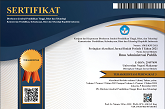The Strategy of the Tourism Office in Managing Tourist Areas on Pelabuhan Ratu Beach, Sukabumi Regency
(1) Public Administrative Science, Universitas Muhammadiyah Sukabumi, Indonesia
(2) Public Administrative Science, Universitas Muhammadiyah Sukabumi, Indonesia
(3) Public Administrative Science, Universitas Muhammadiyah Sukabumi, Indonesia
(*) Corresponding Author
DOI: https://doi.org/10.26858/jiap.v13i1.47555
Abstract
The Pelabuhan Ratu Beach area is a mainstay tourist spot for the people of Sukabumi Regency because it has a lot of interesting tourism potential. The purpose of this study is to determine the strategy of the Tourism Office in the management of tourist areas on Pelabuhan Ratu Beach. The problems identified related to its management are still not optimal in increasing the capacity of tourism resources and maintenance/procurement/rehabilitation of facilities and infrastructure so that the number of tourists coming to the Pelabuhan Ratu Beach area will decrease. This research uses qualitative research methods with a descriptive approach. and data collection techniques, namely observation, interviews and documentation. Then the data analysis stage by reducing data, presenting data and drawing conclusions. The results of this study are measured by three dimensions proposed by Dess & Miller, namely goals, policy, and plans. The results in this study show that in increasing tourist visits, related agencies are improving the arrangement of tourist areas around Pelabuhan Ratu Beach to make it even better. Such as paying attention to the 4A aspects (attaraction, accessbility, amenity, and ancilliary and improving tourism destination marketing strategies. Meanwhile, in increasing the capacity of tourism resources, monitoring and evaluation are carried out by conducting trainings. Then plans in the procurement/ maintenance/rehabilitation of facilities and infrastructure, namely by transferring and eliminating facilities and infrastructure.
Keywords
Full Text:
PDFReferences
Affandi, A. (2017). Peran pemerintah daerah dalam pengembangan destinasi wisata bahari Pulau Gili Noko Kabupaten Gresik. 49.
Aristyawan, D. (2021). Strategi Promosi Wisata Heritage melalui Media Sosial, Komunitas dan Event (Studi Kasus pada Dinas dan Kebudayaan Pariwisata Kota Surabaya). The Commercium: Jurnal Komunikasi, 4(2), 1–15.
Bahiyah, C., & Hidayat, W. R. (2018). Strategi Pengembangan Potensi Pariwisata Di Pantai Duta Kabupaten Probolinggo. Jurnal Ilmu Ekonomi, 2, 95–103.
Çakmak, E., Lie, R., & McCabe, S. (2018). Reframing informal tourism entrepreneurial practices: Capital and field relations structuring the informal tourism economy of Chiang Mai. Annals of Tourism Research, 72, 37–47. https://doi.org/https://doi.org/10.1016/j.annals.2018.06.003
Camisón, C., & Monfort-Mir, V. M. (2012). Measuring innovation in tourism from the Schumpeterian and the dynamic-capabilities perspectives. Tourism Management, 33(4), 776–789. https://doi.org/10.1016/j.tourman.2011.08.012
Cioccio, L. (2007). Hazard or disaster: Tourism management for the inevitable in Northeast Victoria. Tourism Management, 28(1), 1–11. https://doi.org/10.1016/j.tourman.2005.07.015
Creswell, J. W. (2019). research Design pendekatan metode kualitatif, kuantitatif, dan campuran. pustaka pelajar: Yogyakarta.
Creswell, J. W., & Creswell, J. D. (2017). Research design: Qualitative, quantitative, and mixed methods approaches. Sage publications.
Desi, Nugraheni & Yusman, F. (2013). DITINJAU DARI SEGI PENGELOLAAN DAN PEMASARANNYA Indonesia merupakan negara kepulauan yang kaya akan sumber daya alam , dimana sumber daya tersebut dijadikan sebagai daya tarik wisata ( Fandeli , 1995 ). Potensi wisata tersebut suatu wilayah sering mampu m. 2(1), 110–123.
Grissemann, U. S., Pikkemaat, B., & Weger, C. (2013). Antecedents of innovation activities in tourism: An empirical investigation of the Alpine hospitality industry. Turizam: Međunarodni Znanstveno-Stručni Časopis, 61(1), 7–27.
Inoue, Y., & Lee, S. (2011). Effects of different dimensions of corporate social responsibility on corporate financial performance in tourism-related industries. Tourism Management, 32(4), 790–804. https://doi.org/10.1016/j.tourman.2010.06.019
Ismail, M. (2020). Strategi Pengembangan Pariwisata Provinsi Papua. Matra Pembaruan, 4(1), 59–69. https://doi.org/10.21787/mp.4.1.2020.59-69
Ji, F., Wang, F., & Wu, B. (2023). How does virtual tourism involvement impact the social education effect of cultural heritage? Journal of Destination Marketing & Management, 28, 100779. https://doi.org/https://doi.org/10.1016/j.jdmm.2023.100779
Liu, J., Li, J., Jang, S. (Shawn), & Zhao, Y. (2022). Understanding tourists’ environmentally responsible behavior at coastal tourism destinations. Marine Policy, 143, 105178. https://doi.org/https://doi.org/10.1016/j.marpol.2022.105178
Macbeth, J. (2005). Towards an ethics platform for tourism. Annals of Tourism Research, 32(4), 962–984. https://doi.org/https://doi.org/10.1016/j.annals.2004.11.005
Miles, M. B., Huberman, A. M., & Saldana, J. (2014). Qualitative Data Analysis: A Methods Sourcebook (3rd ed.). Sage Publications.
Pratiwi, F. R. (2022). Strategi Dinas Pariwisata Untuk Meningkatkan Pendapatan Asli Daerah. Jurnal Ilmiah Muqoddimah: Jurnal Ilmu Sosial, Politik Dan Hummanioramaniora, 6(1), 188. https://doi.org/10.31604/jim.v6i1.2022.188-194
Smart cities, smart tourism, and smart mobilities. (2019). In Handbook of Globalisation and Tourism. Edward Elgar Publishing. https://doi.org/10.4337/9781786431295.00033
Sugiyono, prof. D. (2019). metode penelitian kuantitatif, kualitatif, dan R&D. alfabeta : bandung.
Syam, H. (2021). Google SketchUp and Lumion Based Marine Tourism Destination Development Design. Turkish Journal of Computer and Mathematics Education (TURCOMAT).
Taufiqurokman. (2016). Manajemen Strategik. In Ilmu Sosial dan Ilmu Politik Universitas Prof. Dr. Moestopo Beragama.
Tesfa Regassa, M., & Xin, Z. (2022). Assessment of tourism industry in Gondar City, Ethiopia. GeoJournal, 87(2), 1161–1173. https://doi.org/10.1007/s10708-020-10299-w
Uran Maravić, M., Križaj, D., & Lesjak, M. (2015). Innovation in Slovenian tourism organisations. Tourism and Hospitality Management, 21(1), 51–62.
Yang, J., Ryan, C., & Zhang, L. (2013). Social conflict in communities impacted by tourism. Tourism Management, 35, 82–93. https://doi.org/https://doi.org/10.1016/j.tourman.2012.06.002
Article Metrics
Abstract view : 89 times | PDF view : 11 timesRefbacks
- There are currently no refbacks.
Copyright (c) 2023 Neng Alvi Hasanah, Tuah Nur, Dine Meigawati

This work is licensed under a Creative Commons Attribution 4.0 International License.
Diterbitkan oleh:
Program Studi Ilmu Administrasi Publik
Program Pascasarjana Universitas Negeri Makassar
JIAP Index By:

This work is licensed under a Creative Commons Attribution 4.0 International License.









